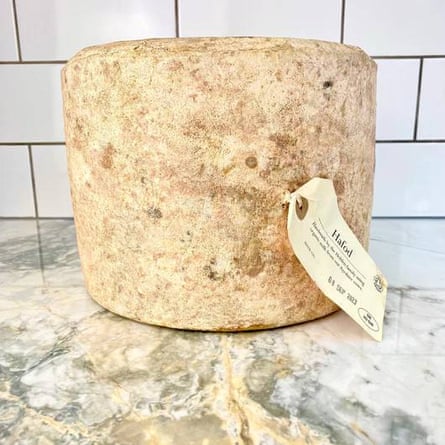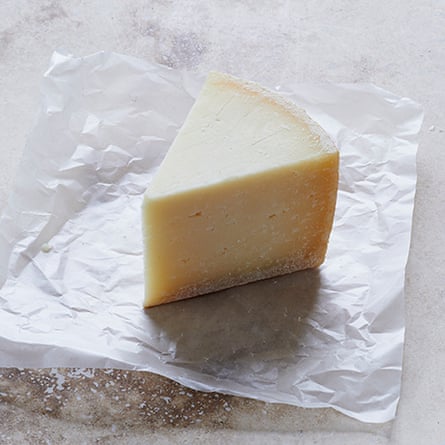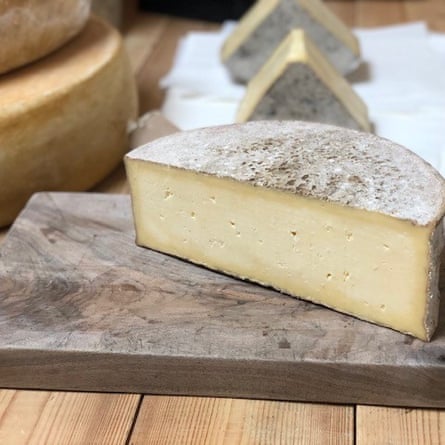The fruity tang of a strong cheddar; the creamy ooze of a brie; the honk of a blue so ripe it threatens to walk off the board. To cheese lovers, these are as much a part of this season’s sensory joys as mince pies and a Christmas tree glowing with lights.
Yet they can come at an environmental price. Sustainability is frustratingly complicated for those of us who want to lay on a cheeseboard without guilt this Christmas. Most of us now know about livestock emissions, global deforestation in the name of producing feed, and the pollution – via agricultural runoff – of local waterways. A few years ago, we were told being sustainable meant avoiding dairy completely; then we learned about the benefits ruminants can bring to the soil when farmed regeneratively.
Many factors involved in the making of cheese dictate its impact on the environment: the animals, the pasture, the farm, the dairy – and it depends on the place too. “What’s right for a farm in north Scotland isn’t necessarily right for a farm in the south-west of England,” says Andy Swinscoe, co-owner of The Courtyard Dairy in North Yorkshire.
For the sake of air miles and simplicity, this list focuses on British cheese – but that doesn’t mean there aren’t brilliant examples of sustainable cheeses abroad. “The Alps, in particular, have amazing producers who work sustainably because they’ve always farmed that way and have little option,” says Swinscoe – feed, cheap fuel and fertiliser being hard to transport in great quantities. In cheese, as in so much of life, the most sustainable solution often lies in “looking to what our grandparents would have done”.
With this in mind, we’ve rounded up the tastiest, most sustainable cheeses around. Bring out the crackers!
At a glance
The best sustainable British cheeses for your Christmas cheeseboard
The cheddar:
Hafod

From £7.15 at the Little Cheesemonger
From £7.75 at the Courtyard Dairy
This cheddar has a soft, buttery texture with a rich, yet mellow flavour. It’s produced using techniques inspired by century-old cheese making at Holden Farm Dairy on the Bwlchwernen Fawr farm in west Wales. Hafod is “front and centre of the list of cheeses that delivers in every respect [regarding sustainability],” says Bronwen Percival, cheese buyer for Neal’s Yard Dairy in London.
Bwlchwernen Fawr is the longest-established organic dairy farm in Wales, and its Ayrshire cows are ideally suited to its climate and geography. Mob grazing – moving the herd around the farm to graze – means the permanent pasture benefits from the work of the ruminants’ hooves and manure without becoming overgrazed.
The wensleydale:
Stonebeck
From £17 at Paxton & Whitfield
From £15.50 at Neal’s Yard Dairy
Forget pasty, crumbly, industrially manufactured wensleydales studded with cranberries: Stonebeck is the real deal, and infinitely more sustainable. It’s buttery and pliant, with a rich complex flavour that will change your perception of wensleydale for ever. “It’s an attempt to recreate a farmhouse wensleydale as it would have been made in the 19th century,” says Percival.
The milk for the cheese comes from a herd of Northern Dairy Shorthorns, a cow breed native to the Dales, which can subsist almost exclusively on pasture, so there is little need to supplement the diet. The cheese, made to a recipe owners Andrew and Sally Hattan devised from historic cheese-making books and interviews with a 101-year-old local cheese maker, is “uniquely designed and evolved to make the best use of milk from those cows”, Percival says.
The wildflower meadows, moorland and pasture that constitute the farm in Nidderdale in Yorkshire provide the perfect environment for insects, small mammals and birds, and by making the cheese in spring and summer, the Hattans ensure it reflects and complements the surrounding rich biodiversity.
The ‘camembert’:
Corscombe
If you can’t bear a board without a camembert, look to Corscombe from Hollis Mead Organic Dairy, with its velvety rind and creamy inside oozing with notes of garlic and raw mushroom. One of the reasons it’s relatively hard to find truly sustainable cheeses in the UK is that the dairy industry “was designed to cater around productivity,” says Percival, “and while this is changing, it’s not surprising that the most progressive farms have set up systems with environmental aims at their core, rather than trying to evolve that way.”
One such farm is Hollis Mead, which is certified organic and pasture fed. Since taking ownership of the land in 1998, Oliver and Charlie Hemsley have planted more than 20km of new hedgerows, and their soil is regularly monitored to measure carbon sequestration. “The farm was designed as a forage-based operation, and it’s driven by sustainability ideals. The cheese is almost a byproduct of that,” says Percival. And it’s still delicious, thanks to the assistance of Ivan Larcher: a cheese consultant who specialises in camembert styles.
The goat’s:
Sinodun Hill and Polmarkyn Dairy
This pyramid-shaped cheese boasts a light, citrus flavour that deepens and becomes fruitier as it ages and a creamy, mousse-like texture. “Ninety-five per cent of goat dairy in the UK comes from goats that aren’t pasture-fed at all,” says Swinscoe. The British climate doesn’t allow for it. “Most commercial breeds are bred for staying indoors and eating cereal-based food all year round.”
One exception to that rule is Sinodun Hill, produced by cheese makers Fraser Norton and Rachel Yarrow, whose herd feed on hay from wildflower meadows throughout the year, and during the spring and summer graze on permanent pasture at the Earth Trust farm in Oxfordshire.
£6.20 at Hanson Fine Foods
£9.50 at the Cornish Food Box Company
Polmarkyn Organic Dairy produces three cheeses: a crumbly Polmarkyn white; a subtle, slightly gooey Polmarkyn blue; and Polmarkyn grey dusted with ash: “all very different, all very delicious,” says Nick Jefferson of Wylde, the online farmers market. Polmarkyn made headlines in January when co-owner Glynn put out a plea for Christmas trees for the goats to eat, to supplement their diet of vegetables and hay during winter. During summer, these goats are – unusually, for goats in the UK – out on Bodmin Moor, grazing on their 18-acre small holding.
after newsletter promotion
The ‘manchego’:
Corra Linn

From £9.90 at the Cheese Lady
From £10.65 at the Courtyard Dairy
The blue:
Lanark blue
£9.95 at Pong Cheese
From £11.30 at the Courtyard Dairy
The Errington family produces several sheep milk cheeses in Scotland’s Pentland Hills. Its best-known is the Lanark blue but Corra Linn – a nutty, slightly sweet manchego-style cheese – came about as a means of using up the glut of ewes’ milk they get in the spring and early summer. They needed a cheese that could age for longer than the blue, which is best at about four months.
Though not traditional to the UK, the Lacaune sheep is well suited to the rough, harsh environment of the Pentland Hills. The family installed 20KW wind turbines in 2012 to reduce their carbon footprint and capitalise on being in one of the windiest corners of the UK.
The Erringtons grow as much of their winter feed as they can – barley, silage, hay – and the sheep graze outdoors during the spring and summer. Both cheeses are made only when the sheep are naturally in season, so the ewes can have a rest from lambing and weaning. “The lambs are straight on to grass, there’s plenty of food, and the cheese reflects the quality of the pasture,” says Swinscoe.
The caerphilly:
Duckett’s caerphilly

Caerphilly has historically been made by Somerset cheddar makers to generate short-term income while their cheddars mature. Somerset-based Westcombe Dairy’s is tangy and clean-tasting, with notes of raw mushroom and a pale, crumbly interior, contrasting with the more buttery texture beneath the rind.
Westcombe is a good example of an old-school producer making great strides to improve its sustainability credentials. Since Tom Calver took over from his dad in 2008, the dairy has been “on a trajectory from a more intensive to a grazing-based system”, says Neal’s Yard Dairy’s Percival. It has moved away from mechanisation as much as possible, and the farm’s pastures have been diversified and enriched with herbal leys and fruit and nut trees.
The reblochon:
Rollright
£10.95 at the Newt
From £10.25 at the Courtyard Dairy
No Christmas cheeseboard would be complete without a reblochon-style cheese, and there’s no better example of the style in the UK than that made by David Jowett. It’s buttery and soft, wrapped in the spruce band that’s traditional for reblochon, and reminiscent of its biodiverse pastures.
Milk for this cheese comes from Manor Farm Chedworth in Gloucestershire, which in recent years has been transitioning its herd towards the more traditional Dairy Shorthorn breed of cows. These are farmed alongside friesians in a low-input organic system. Pastures are rich in clover and native grasses, and the farm is focused on biodiversity, soil structure and carbon sequestration.
What makes cheese sustainable?
“There are so many different ways to construe sustainability,” says Percival. “The good news is that consumer interest is rising; in a recent survey by the Real Cheese Project, over 75% of respondents would pay more for local milk and more sustainable production. The bad news is that terms like ‘regenerative’ have become buzzwords, which lend a feelgood factor, but have no concrete definition.” That renders them confusing at best and open to greenwashing at worst. Carbon counts still count, but so does biodiversity, and the welfare of the people and animals behind the cheese.
Soon, Neal’s Yard Dairy hopes to have a clear label to cover all these areas, and the aim is to encourage consumers and investors alike to support cheese made better. With the Sustainable Food Trust, the dairy is inviting farmhouse cheese makers to complete a global measure of sustainability, designed to help farmers measure and report on their impacts holistically. “The Global Farm Metric tool looks at their strengths and weaknesses across 12 categories – not just emissions and carbon sequestration [the capturing of carbon in soil], but also biodiversity, protecting watercourses, animal welfare, fair wages paid to staff and so on,” says Percival.
The tool will mean customers can be assured they’re “purchasing cheese that is directly helping the renaissance of culturally, biologically and properly sustainable food systems”, says Patrick Holden, the Sustainable Food Trust’s founder and CEO and the maker of Hafod.
In the meantime, those who love a label should look for “organic” or “Pasture for Life”: “They’re not perfect, but certain criteria have been met,” says Percival. “They represent something specific that has been accredited.”
Bear in mind, though, that several farmers and cheese makers who are making strides in sustainability aren’t certified with either, because accreditation is expensive, or because both have their flaws.
As for those who prefer their stilton without the sermon – fair enough, though it’s worth keeping in mind that sustainable systems benefit the cheese as much as the land and animals. “If you have healthier soils, you have parallel benefits: more nutrient-dense food and more delicious food too, because deliciousness is often connected to these micronutrients,” says Holden. “The quality of the cheese is directly affected by what the cows or sheep are grazing. You are what you eat, so by extension, you are what you eat has eaten.”
Clare Finney is an award-winning food writer










